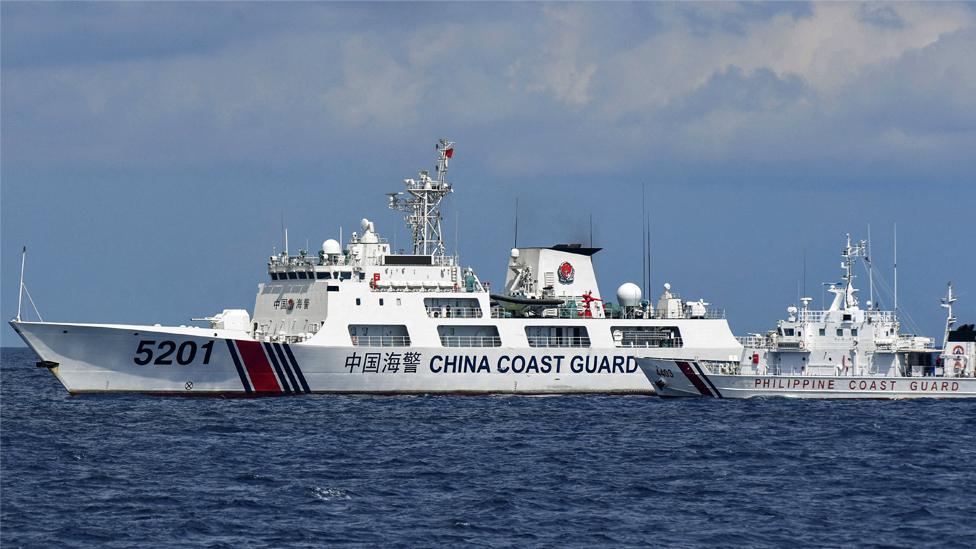South China Sea: Why the Philippines and China are on a collision course
- Published
Watch: Boats collide in South China Sea's disputed waters
Take a close look at a video of Sunday's "collision" between a Philippine coastguard ship and a Chinese maritime militia vessel in the South China Sea.
As the stern of one bumps the deck of the other, right in the middle of the frame is a Filipino television crew scrambling to get what in the business is called an "action piece to camera".
The confrontation between Manila and Beijing over submerged shoals in the South China Sea has been going on for decades.
But in recent months something has changed. The spats at sea are now unfolding in the full glare of the television media. This is the second time in weeks Philippine journalists have filmed a close encounter near a particularly sensitive reef known variously as Second Thomas Shoal, Ayungin Shoal or Ren Ai Reef.
This is no accident. It is part of a deliberate policy by the Philippine government to shine a spotlight on what it has called China's "brute force" in asserting control over what Manila says are its waters.
"I think we've seen a significant change this year. It's what I call an assertive transparency campaign," says retired Colonel Raymond Powell of Stanford University's Gordian Knot Centre.
Starting in January, the Philippine government began feeding more video of the encounters to local media. By summer it was taking more and more journalists, including the BBC, aboard its boats and aircraft heading out into the disputed waters.
"It's been like turning on a light to show China's grey zone operations," Col Powell says.
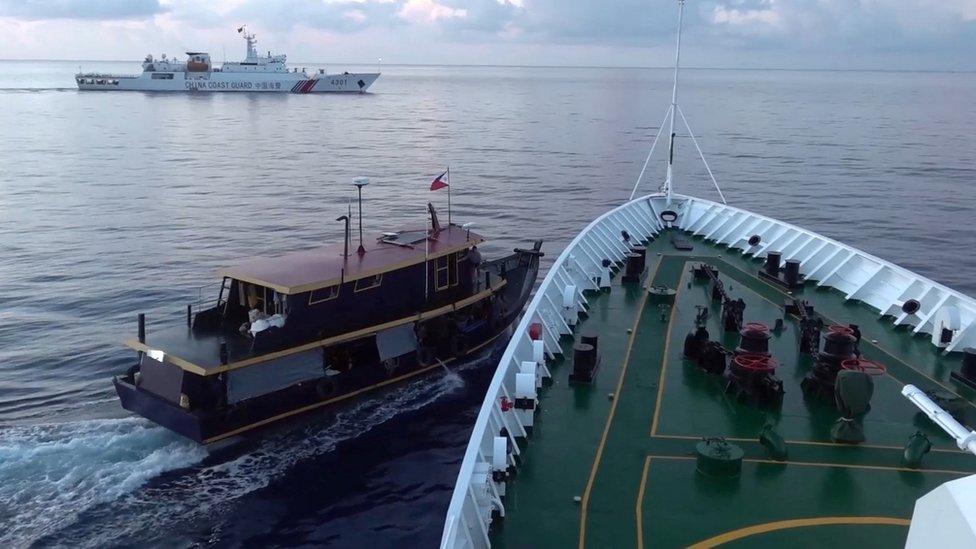
The Filipino vessel was on its way Sunday to a Philippine outpost in the Second Thomas Shoal
China appears to have been taken aback by these new tactics.
For a while it looked like the strategy was working, says Oriana Skylar Mastro of the Freeman Spogli Institute for International Studies: "We saw a bit of a lull in China's activities."
Beijing eased off and Manila was able to make several re-supply runs to an outpost it has on Second Thomas Shoal - an aged World War II-era landing ship called the Sierra Madre.
It was deliberately grounded on the reef in 1999. Since then, a tiny contingent of Philippine marines has kept lonely watch aboard the rusting hulk as it has gradually begun to fall apart. In 2014 a BBC team went aboard the ship. Even then it was in terrible condition with huge holes in its sides, and waves splashing through the structure.
Most analysts believe China has been content to play the long game. When relations between Beijing and Manila have been good China's coastguard has allowed resupplies to the Sierra Madre to go ahead. When relations have turned sour, they have moved to block the resupply ships.
But Beijing's overall assessment is that the Sierra Madre cannot last forever, and at some point, the Philippines will be forced to evacuate the marines, as the ship crumbles into the sea.
During the six years under former president Rodrigo Duterte that assumption appeared well-founded. But since the election of President Ferdinand Marcos Jr last year, the Philippines' foreign policy has turned 180 degrees.
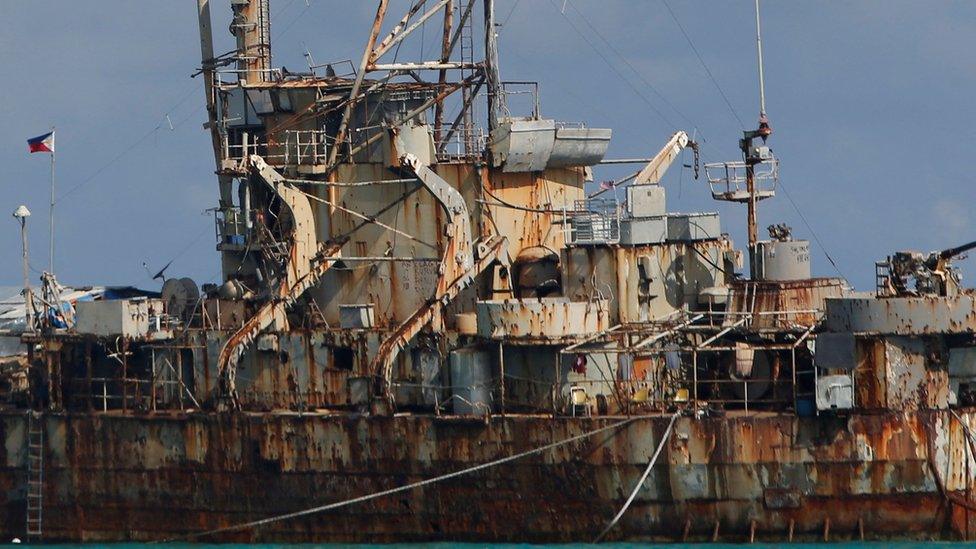
A handful of Filipino troops are stationed on the crumbling Sierra Madre
Not only has President Marcos reversed Mr Duterte's policy of cosying up to Beijing, he has fully re-embraced the alliance with the United States and begun shouting loudly about China's incursions into Manila's 200-nautical mile Exclusive Economic Zone.
There's more. Sources in Manila say food and water is not the only thing the Philippines has been taking out to the Sierra Madre on resupply runs. They say it has quietly been shipping construction materials, including cement and scaffolding. The aim: to shore up the rusting ship.
"It's very hard to see how they could extend the life of the ship," Col Powell says. "I think we're coming to a crisis point. The end is near for the Sierra Madre. It could break up very soon."
Perhaps it is this new sense of urgency that is pushing both Manila and Beijing to greater assertiveness. The Philippines is desperate to cling to its presence on Ayungen Shoal. And Beijing is once again reiterating its power, determined that the Sierra Madre will not survive.
But if the Sierra Madre does finally crumble into the aquamarine waters of the South China Sea - or West Philippine Sea as its called in Manila - what happens then?
Will Beijing swoop in and attempt to seize control of the reef as it has done elsewhere in the South China Sea? Will Manila attempt to ground another vessel on Ayungin Shoal? And how will Washington react?
No-one knows but that day is coming, perhaps quite soon.
Related topics
- Published22 October 2023
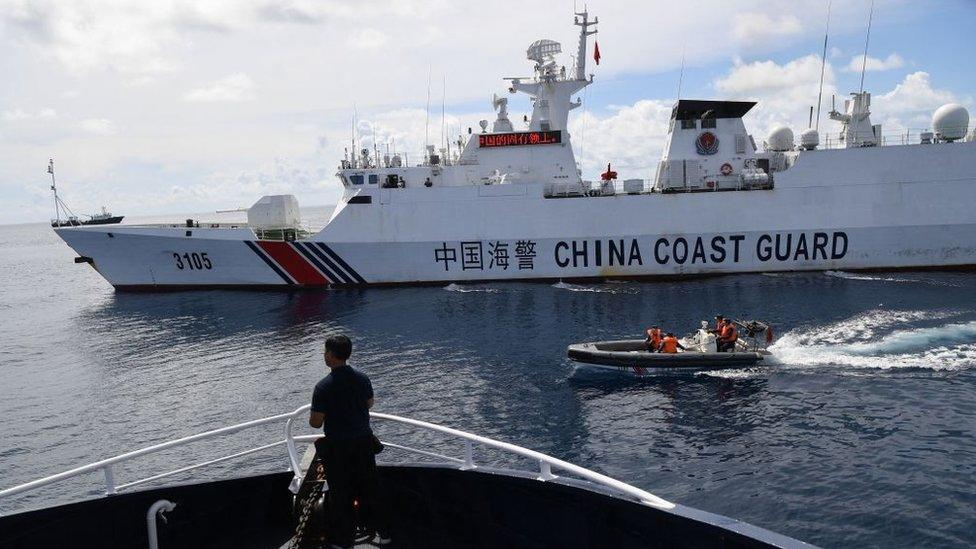
- Published7 July 2023
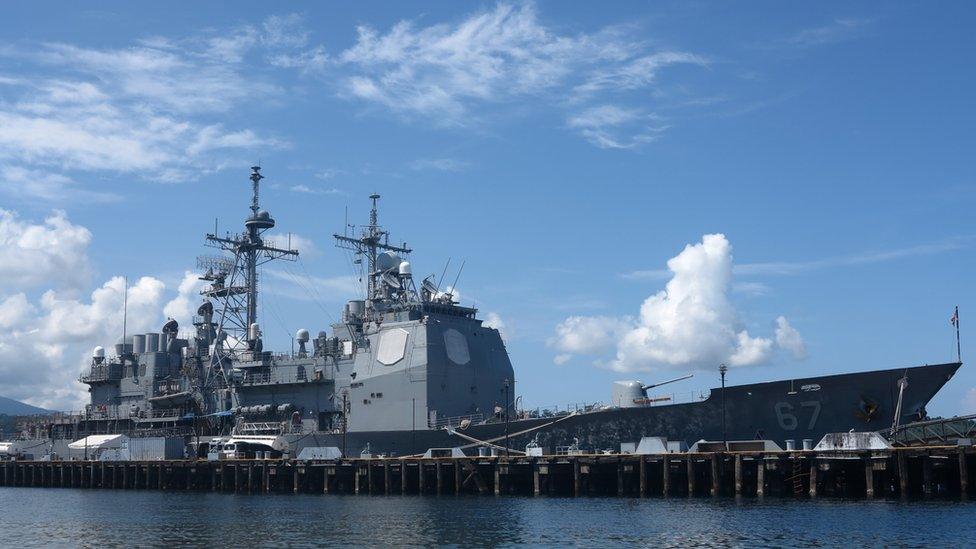
- Published1 September 2023

- Published28 April 2023
